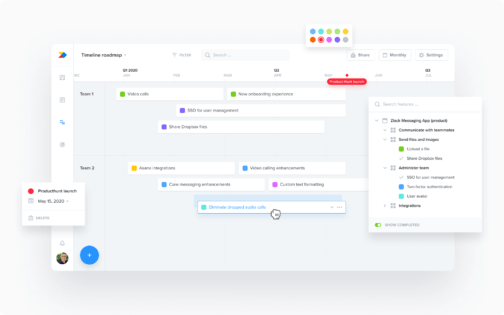The secret ingredient to building a product roadmap? Collaboration.

Product roadmaps are a visual representation of where a company’s product is headed — they are perhaps the most visible contribution of the product team. And though owned by product managers, these roadmaps impact the work of diverse stakeholders whose voices are often missing from the final product.
Product discovery expert Teresa Torres neatly summarizes the downfalls of a roadmap created in isolation:
“When we present backlogs full of user stories and roadmaps full of features and release dates — we are asking our stakeholders to give us their opinions on those outputs. And more often than not, they are going to have their own opinions about what you should build. They aren’t going to be aligned with your opinions because you haven’t shown your work. You haven’t shown why these outputs matter.”
The secret ingredient to roadmap success is collaboration. That means that all stakeholders — leadership, sales, marketing, engineering, and more — understand what is on the roadmap and why. Even better, their needs are considered, and they know why their request has been included (or why not).
This collaboration results in a product roadmap with built-in stakeholder buy-in as well as products more likely to deliver real value.
Why collaboration is the key to building a product roadmap
Collaboration is key to building a product roadmap. After all, where the product is headed (and why) impacts everyone in the company. Consider the following:
- The product roadmap represents outcomes that affect everyone. Everyone’s success —from top-level executives to individual contributors — is tied in one way or another to the product. Thus, it makes sense to build a roadmap that considers the needs of everyone — not just the product team.
- Other departments have additional insights. Stakeholders have knowledge and expertise that stretch outside of the product team’s domain. Unlike sales, customer success, and support, for example, product managers don’t spend their days talking directly to users. Getting these insights from customer-facing teams is essential for creating a roadmap that focuses on the real needs and concerns of those using your product day-to-day.
- You need buy-in from stakeholders. Oftentimes, product managers do not have the authority to push through product decisions without explanation. Instead, they must use influence and soft skills to earn support. That’s why engaging stakeholders from the get-go is so important. Not only can this proactive approach help uncover fresh insights and reduce risk, involving stakeholders and getting their buy-in early ensures that significant resources, time, and work don’t go to waste.
In short, involving a variety of stakeholders in the development of a product roadmap provides the context, shared ownership, and collaboration needed to bring new products and features to life.

The best way to collaborate when building a product roadmap
As the primary owner of the roadmap, it’s your responsibility to include stakeholders every step of the way.
This begins with determining who your stakeholders are. For most companies, your stakeholders will be sales, engineering, marketing, customer support, executives, and of course, your product team. Essentially though, you should be looking for any departments that regularly interact with customers or have a high-level view of company and product strategy. It’s also important to include anyone who wields influence in the product management process (like leadership and investors, for example).
Once you know who your stakeholders are, collaborate on the roadmapping process at these stages:
Step 1: Identify your product strategy & priorities
The goal of your product roadmap is to articulate your product strategy in a way that everyone can understand. It should clearly show the overarching direction of your product and what you plan to accomplish along the way.
You, the product manager, should meet separately with all stakeholder groups.
Start the discussion with your executives. Define the high-level goals of the product(s). Where do you want the product to be by the end of the quarter? Discuss how you can tie product strategy with high-level company objectives.
Say your company aims to grow revenue by 25% in 2020. A product goal that supports this company goal might be “Reach 25K paid subscribers by Q3.” This exercise helps ensure that the product roadmap aligns with what your company is trying to accomplish overall.
Meet with other stakeholders. Communicate the strategy you nail down with the higher-ups that will inform your product roadmap. At this point, stakeholders should share what products or features they want to prioritize and why. Sales might think it’s better to create a specific feature this quarter because of insights surfaced during product demos. Engineering might bring attention to technical debt and bugs that have potential to hinder progress. Make sure stakeholders have the data to back up their reasoning.
Priorities across teams will likely be conflicting, but assign a priority ranking to ideas that each team deems necessary and assess them against your overall strategy. You’ll come back to these rankings later, but surveying all inputs from different teams changes your thinking from “I think I know what we should be building” to “We’re making this decision because of XYZ.”
Step 2: Share product priorities
When PMs “share their work,” as Teresa Torres puts it, they ensure that all stakeholders, from the beginning, are on the same page about what to build next and why. Work with your product team to review all stakeholder inputs and their priorities (and additional factors, of course), and then create a working draft of your roadmap.
This step can become a little overwhelming given the sheer volume of information you’re working with. This is where it helps to have a tool that organizes insights in one place. Also, use a product prioritization framework to assess inputs and priority rankings you received from stakeholders.
Use the following framework questions as a guide:
- Are we working on items with the highest business value?
- Are we delivering necessary value to customers?
- Does our work contribute to broader business objectives?
- Can we get this product to the market within a reasonable timeframe?
Once you have a working roadmap draft, communicate the order of priorities to avoid misaligned expectations with stakeholders later on. Hold a kickoff call with stakeholders to discuss the ranked product roadmap (e.g. your understanding of their original inputs, the lineup of priorities, and roles of different teams). Think of it as a “Here’s what I think you said. Is that correct?” exercise.
This meeting should get stakeholders excited about the product direction and confirm priorities. You will likely face pressure with feature prioritization, but tie everything back to the product strategy you nailed down at the beginning of the process.
As product thought leader and consultant Rich Mironov puts it, “No matter what everybody wishes for, we live in a world where we only get to do five things, not a world where we can add unlimited new things. Once we make that clear, we can be hard-nosed about which new features or capabilities we put into production and how we make those tradeoffs.”
When you include stakeholders from the beginning, it is much easier to do what Rich advises.
Step 3: Design and refine the roadmap based on inputs
Your inputs from the previous two steps will help you and your product team design a comprehensive structure for your final product roadmap. And as you create your roadmap, include these elements to keep it simple and informative for your end audience:
- Timeline. Help your audience understand when short-term, medium-term, and long-term features will roll out. We’re not talking about specific dates or deadlines. Instead, show the general time a feature will be completed, such as the month.
- Features. Communicate what features you want to roll out in the above timeline. You can be as high-level or as detailed as you want, just explain why you are including each feature to give context.
- Goals. Let all teams know where the product is headed and what goals you’re trying to reach. These goals might be product-based or business-related (e.g., increase monthly active users by 5%).
Defining and refining your roadmap is done by you alone, or together with your product team. Regardless, its creation is separate from the outside input of the rest of your company at this point. The goal is to create a product roadmap that neatly organizes all inputs and is easy to understand. From here, you can show your stakeholders.
Step 4: Communicate the final direction of the product roadmap with stakeholders
Your roadmap is ready for review by stakeholders. “Communication, communication, communication” should be your mantra from here on out. Provide product roadmap access to all members involved in the product development process. An easy way to do this is through a product roadmapping tool so stakeholders can view and track changes at any time.
Stakeholder review shouldn’t only happen when the roadmap is first created. Stakeholders should be involved throughout the life of the roadmap. An ongoing communication strategy ensures that all key stakeholders are aware of the progress being made with the product. Set up a regular meeting cadence (e.g. quarterly meetings with executives, monthly meetings with sales), as well as sending emails updating the team about any product roadmap changes.
Regular communication about the product roadmap creates an agile product process. Stakeholders involved in the process can course-correct their tasks and projects if they know that there are delays or changes. Input based on using the roadmap will also help create a new roadmap next quarter.
Collaboration is the key to a successful product roadmap
Creating a product that the customer will actually use is the desired outcome of your product roadmap. But without input from different departments, you’ll be left with a roadmap that lacks the context and direction to help take your product across the finish line.
Granted, the collaboration process isn’t always easy — too many hands in the pot can quickly become overwhelming. But, accompanied by a clear product strategy, a collaborative roadmap is well worth the effort. Not only do stakeholders feel shared ownership over the roadmap, you reduce the chances of misunderstandings about the product’s direction between teams. And, most importantly, you create a product that offers genuine value to your customer.
. . .
Productboard is a product management system that enables teams to get the right products to market faster. Built on top of the Product Excellence framework, Productboard serves as the dedicated system of record for product managers and aligns everyone on the right features to build next. Access a free trial of Productboard today.






